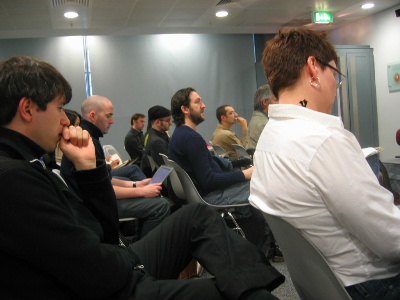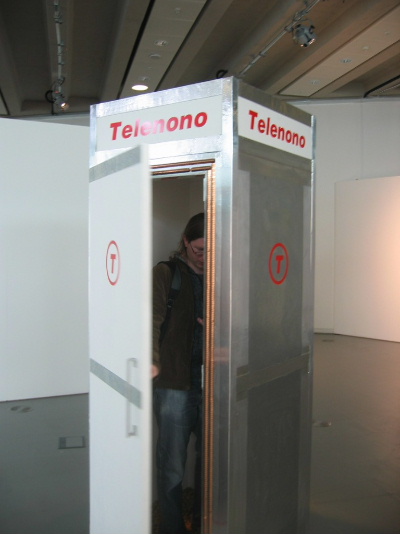Report from Futuresonic 2004
Mobile Connections
April 30 – May 1, 2004
http://www.futureeverything.com
Held in the oblong shaped, glass-surfaced, URBIS center in Manchester, UK, the Futuresonic festival began with a conference focused on the theme of “Mobile Connections”, or the role of mobile technology and location-based media in creative arts practice. Covering everything from mixed reality mobile gaming to mobile ad-hoc networking to biometric recording devices, the conference and accompanying exhibition provided a concise overview and impressive showcase of emerging mobile media projects.
Media theorist Sadie Plant opened the event with a keynote address on the history of technology-mediated communication and the social ramifications of this phenomenon on our daily lives. She outlined how human behavior shifts when communication is siphoned through different mediums. For instance, when using the Internet a typical question asked among users is “Who are you?” since anonymity of identity remains important. In contrast, the fixed telephone causes people to ask “How are you?” since in most cases you already know who you are calling and it being a specific location. Finally, the mobile telephone sees people asking “Where are you?” since their location plays a key role in determining the type and duration of the conversation. These subtle clues attest to how people adapt to shifting contexts of interaction and how these nuances play out within the corresponding spaces of each device.
Following this discussion was the “Network Commons” panel, moderated by Armin Mendosch, which brought up some interesting debate and arguments centering around the use and deployment of community wireless networks in urban areas. I presented my Wifi-Hog project as an example of a device that challenges the claim of ownership over public wireless spaces by corporate nodes looking to populate urban centers with their pay-per-use networks. Although the project has received numerous negative reactions from proponents of free networks, its main point is to examine both the positive and negative effects of territorialism with networks that seep from private spaces into public areas. Also on the panel, Adam Burns from London’s Consume.net outlined a plan for ways community groups could overthrow the mobile carriers by building home-spun GSM access points. However, this approach still requires centralized access points, placing control in the hands of few. In contrast, an ad-hoc network approach would allow everyone to be a router and pass information directly to each other without the need for a central relay.
The second day featured a keynote by Matt Adams of Blast Theory, the artist group responsible for launching a wave of pervasive gaming projects, most notably “Can You See Me Now?” and “Uncle Roy All Around You”. These games pit online players against “runners” on the street who try to chase each aother down in both spaces simultaneously through the use of mobile digital devices and wireless technology. Adam’s speech outlined a remake of Hakim Bey’s “Temporary Autonomous Zones”, where instead of merely occupying a space in physical proximity and association, technology mediated spaces affect our actions and thus produce “Temporary Performative Zones”. For instance, when receiving a call on a mobile phone we must “perform” to separate ourselves from people in our immediate area or mask our discussions if they become too personal. Halfway through Adams’ talk, he received strong opposition from the audience who accused him of “selling out” to corporate sponsors since his emphasis on the growing mobile communications industry seemed to overshadow his artistic intent with Blast Theory’s work. Although the idea of pure art might seem utopian, Adams was quick to point out that it is “naive to think that this cultural form is independent from the capitalist economy that these devices are coming from.” In a sense, these games and project comment on the current and future uses of these devices as they gain ubiquity.
Getting into the Telenono booth.
The exhibition featured a wide range of work focusing on both the negative and positive effects of mobile technology in physical spaces. One of my favorites was “Mobile Clubbing”, a flash-mob-like urban performance where participants with portable MP3 players and headphones show up in public spaces like train stations and party down. Reactions caught on video by onlookers were amusing. Playing off the health risks of mobile phones was Rupert Griffith’s “Telenono”, a sealed phone booth that supposedly blocks out all radiation from devices such as mobile phones, televisions, radios, and Bluetooth signals. When inside, the booth forces others to physically find you to communicate. Around the URBIS grounds, several projects were on demo that allowed visitors to traverse the urban landscape of Manchester. “InterUrban”, by Naomi Spellman, Jeremy Hight, and Jeff Knowlton, consisted of an interactive narrative that constructed itself based on a person’s movement around the physical grounds such as time of day, distance traveled, and actual direction. Going for abstraction was the Japan-based artist Akitsugu Maebayashi’s “Sonic Interface”, a wearable sonic re-sampler that inputted live audio, remixed it, and spit it back out to the wearer’s headphones. The exhibition traded slick production value for proof of concept and rapid deployment to gain feedback from the attentive audience.
As the conference ended, a prevalent theme seemed to form around the concept of “minimal aesthetics” and social potential. The most successful projects were realized with little technological overhead and simultaneously created a space for collaborative intervention among members of the public or a specific location. Mobile Connections was meant to highlight the rift between location-based media and everyday experience, where technology takes a backseat to human and critical engagement. This was felt at the event, but the question remains if theses devices should maintain a foreground or background role in our everyday lives. Does the effort to interact with a technology overshadow the result of the interaction? Since the inclusion of digital technology in social situations creates tension over accessibility, perhaps increased transparency will help to relieve this conflict. Futuresonic initiated a debate on these questions and provides a good starting point to examine the sociological and personal effect of mobile technology on society at large.
![]()





